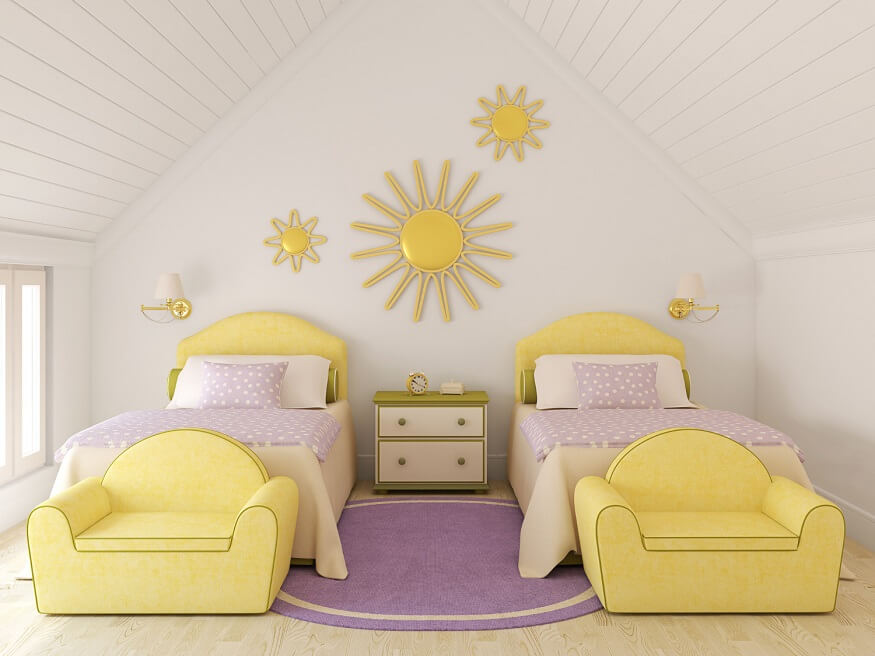Creating a room for siblings to share can be a challenging yet rewarding project. It involves harmonising different personalities, preferences, and needs into a cohesive, functional, and pleasant living space. Here, we outline various tips that can guide you in crafting a room that facilitates sibling harmony and promotes individual growth:
Step 1: Understanding Individual Needs
Consultation and Inclusion: Engage the siblings in the planning process, taking note of their individual needs, preferences, and tastes.
Age-Appropriateness: Consider the ages of the siblings; the room should cater to both their current and future needs.
Functionality: Each sibling should have a designated area that serves their unique functions, such as study, play, or relaxation areas.
Step 2: Layout and Space Utilisation
Symmetry: Strive to create a symmetric layout that gives each sibling equal space and features.
Zoning: Separate the room into different zones to cater to various activities, such as sleeping and studying.
Vertical Space: Utilise vertical space efficiently by installing bunk beds or loft beds, which can save floor space for other furniture and play areas.
Step 3: Furnishing and Storage
Matching Furniture: Opt for matching furniture to foster unity and harmony in the room’s aesthetic.
Personalised Spaces: Encourage personalisation within individual spaces using different colours, bedding, and accessories.
Storage Solutions: Invest in smart storage solutions like under-bed storage, floating shelves, and multi-functional furniture to keep the room organised.
Step 4: Decor and Aesthetics
Neutral Background: Start with a neutral background colour for the walls and floors, allowing for flexibility in decor and easy updates as the siblings grow.
Themed Decor: If the siblings agree, you might opt for a themed decor that reflects their shared interests.
Gallery Wall: Create a gallery wall where each sibling can display their artwork, photos, or accolades, promoting a sense of pride and individuality.
Step 5: Privacy and Independence
Room Dividers: Consider room dividers or privacy screens to delineate individual spaces, fostering a sense of privacy and independence.
Personal Lighting: Ensure each sibling has their personal lighting for reading or working on hobbies without disturbing the other.
Sound Proofing: Incorporate sound-proofing elements such as rugs and curtains to reduce noise transmission between different areas of the room.
Step 6: Flexibility and Adaptability
Adaptable Furniture: Choose furniture that can be adapted to the changing needs of the siblings as they grow.
Flexible Layout: Maintain a flexible layout that allows for re-arrangement of furniture and decor to keep the space refreshing and adaptable to changing needs.
Step 7: Safety and Comfort
Safety Measures: Implement safety measures, especially if there is a considerable age difference between the siblings, including securing furniture to the walls to prevent tipping over.
Comfortable Bedding: Invest in comfortable bedding to ensure each sibling has a cosy sleeping environment.
Step 8: Foster Unity and Harmony
Shared Activities: Create a shared space where the siblings can enjoy activities together, fostering bonding and unity.
Encourage Cooperation: Encourage cooperation and shared responsibility in maintaining the room, fostering teamwork and mutual respect.
Step 9: Maintaining the Room
Easy-to-Clean Materials: Use easy-to-clean materials for flooring and furniture to facilitate maintenance, especially with younger children.
Regular Updates: Regularly update the room to accommodate the evolving needs and preferences of the siblings.
Step 10: Monitoring and Feedback
Feedback Loop: Establish a feedback loop where the siblings can express their opinions on the room setup, facilitating ongoing improvements.
Mediation: In cases of disagreements, be ready to mediate and find mutually agreeable solutions to maintain harmony in the shared space.
By following these comprehensive tips, you are well on your way to creating a room that not only accommodates the distinct needs and preferences of each sibling but also fosters a sense of harmony, cooperation, and shared happiness. Remember, the goal is to craft a space that mirrors a mini-ecosystem where siblings can thrive individually and together. Moreover, a well-planned siblings’ room will serve as a nurturing ground for cultivating lasting bonds, understanding, and mutual respect, as they grow and forge their paths in life. It’s about creating a shared history, filled with laughter, learning, and love—a place where they can be themselves, while also being there for each other.
Important Tips To Remember for creating a room for siblings
Designing a shared space for siblings is a task that requires tact and understanding to foster a harmonious living environment. Here are essential tips to remember:
Consultation and Engagement: Involve the siblings in the design process to encourage a sense of ownership and reduce potential conflicts. Engaging them will help in incorporating their tastes and preferences.
Functionality: Ensure that the room is functional and caters to their daily needs. Consider bespoke storage solutions to accommodate their belongings and aid in maintaining a tidy space.
Privacy: Despite sharing the room, it is paramount to allocate individual spaces to each sibling where they can enjoy their privacy. Consider room dividers or separate zones created using furniture arrangements.
Neutral Ground: While it’s important to infuse individuality, maintaining a neutral ground through cohesive interior design can promote unity. Avoid glaring contrasts; instead, opt for harmonious colour schemes and shared accessories.
Flexible Furnishing: Choose furniture that can adapt to their growing needs. For instance, beds with storage or a study table that can be adjusted as they grow.
Safety: Safeguard the siblings by selecting furniture with rounded edges and avoiding bunk beds for very young children.
Creating a room for siblings can be important. It can help them to bond, learn to share, and develop problem-solving skills. However, it is also important to consider the individual needs of each child, and to make sure that they have enough space to call their own. However, there are also some potential drawbacks to creating a room for siblings. For example, it can be difficult to get enough privacy if the room is small. It can also be noisy if the siblings have different sleep schedules. Ultimately, the decision of whether or not to create a room for siblings is a personal one. There is no right or wrong answer, and the best decision will depend on the individual circumstances of each family.
EuroSchool holds regular parent-teacher conferences. These conferences provide an opportunity for parents and teachers to discuss their child’s progress and to work together to create a plan for their child’s success.











